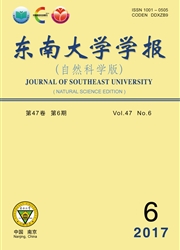

 中文摘要:
中文摘要:
通过在脱硫塔进口烟气、塔内脱硫液进口上方添加适量蒸汽等措施,在湿法烟气脱硫(WFGD)系统中进行了利用蒸汽相变原理高效脱除细颗粒的试验研究.考察了采用CaCO3,Na2CO3,NH3.H2O等3种不同脱硫剂时,WFGD系统对细颗粒的脱除性能及其脱硫剂、蒸汽添加量、液气比(体积比)、脱硫塔进口气液温差等的影响,并进行了添加蒸汽和喷雾化水的对比试验.结果表明,由于形成无机盐气溶胶细颗粒,采用CaCO3,NH3.H2O脱硫剂时,WFGD系统对细颗粒的脱除效果明显差于Na2CO3脱硫剂;在WFGD系统中应用蒸汽相变原理可显著促进细颗粒的脱除,在蒸汽添加量为0.05kg/m3时,细颗粒数浓度脱除效率可增至60%~70%以上;液气比的影响与脱硫塔内是否存在蒸汽相变有关;提高脱硫塔进口气液温差有利于细颗粒脱除;烟气温度较高时,利用雾化液滴的蒸发替代添加蒸汽也能显著促进细颗粒的脱除.
 英文摘要:
英文摘要:
A novel process to remove fine particles with high efficiency by heterogeneous condensation in a wet flue gas desulphurization (WFGD) system is presented. A supersaturated vapor phase, necessary for condensational growth of fine particles, was achieved in the SO2 absorption zone and at the top of the wet FGD scrubber by adding steam in the gas inlet and above the scrubbing liquid inlet of the scrubber, respectively. The condensational grown droplets were then removed by the scrubbing liquid and a high-efficiency demister. The results show that the effectiveness of the WFGD system for removal of fine particles is related to the SO2 absorbent employed. When using CaCO3 and NH3 . H2O to remove SO: from flue gas, the fine particle removal efficiencies are lower than those using Na2CO3 and water as result of the formation of aerosol particles in the limestone and ammoniabased FGD processes. The performance of the WFGD system for removal of fine particles is significantly improved for both steam addition cases, for which the removal efficiency increases with the increasing amount of added steam. Removal efficiency of fine particles can reach to more than 60% 70% while the amount of added steam being 0.05 kg/m^3. A high liquid to gas ratio is beneficial for efficient removal of fine particles by heterogeneous condensation of water vapor. Removal efficiency of fine particles increases with increasing gas-liquid temperature difference at WFGD inlet. High removal efficiency can also be obtained by atomized droplets evaporation in hot flue gas besides steam addition.
 同期刊论文项目
同期刊论文项目
 同项目期刊论文
同项目期刊论文
 期刊信息
期刊信息
